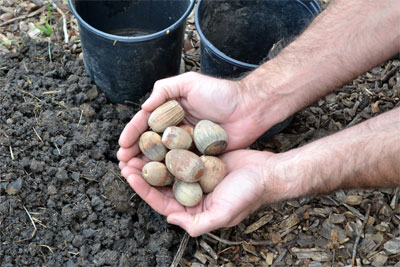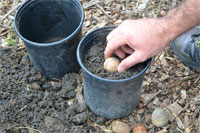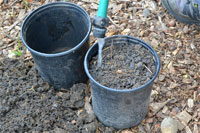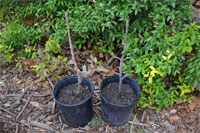Texas Tree Tips

Bur oaks produce large acorns that are easy to gather and plant in containers. Before planting, remove the caps and soak in water overnight. All photos by Bill Seaman.
Seeds for the Future
Why should we plant and care for trees? Research shows that trees clean our air, our water, and our soil. Trees make significant contributions to improve our health, sense of well being, quality of life, and our economic future. According to USDA Forest Service research, the benefits provided by large mature trees are 70 times greater than those of small, recently planted trees. In essence, caring for our existing mature trees provides significant benefits today, while planting young trees benefits future generations.
Many green industry professionals agree that homeowners get the most “bang for the buck” by planting a 2- to 4-inch-diameter (or caliper) tree. There is an immediate effect without spending a fortune. For those with funds in their budget, hiring a professional to plant this size tree works well.
For a less expensive approach to tree planting, and a way to teach children about the many joys of growing a tree, consider planting an acorn for the future. Planting acorns can be a more successful method of establishing a tree than planting a small seedling (or sapling) “gimme tree.” Planting acorns has the following advantages:
- Transporting acorns is convenient. They are not sensitive to wind and temperature and do not have to be watered in transit.
- Locally collected acorns produce trees that are adapted to the same climate and soils.
- An acorn can be planted in a container filled with the same soils it will grow in once it is planted in the landscape, making final establishment quicker.
- Sprouting acorns produce growth that is immediately acclimated and less likely to be “sunburned.”
- Planting acorns in an appropriately sized container allows for the growth of a root system that successfully transplants into the landscape and requires less frequent watering.
All of these factors reinforce the idea that a properly planted acorn from a local tree is likely to grow into a healthy mature tree.
How to Plant an Acorn

Fill a 1- to 2-gallon container with native soil and place the acorn on its side. Cover the acorn with 1 to 2 inches of soil.
Step 1: Select an acorn. Discard any acorns that are cracked or have holes in the shell. Place the acorn in water and let it soak for 24 hours. If it floats in the water, it will not grow, and another acorn is required.
Step 2: Find a 1- or 2-gallon container that has holes in the bottom for proper drainage (drill or poke holes if necessary). Fill the container with soil from the same location in which the tree will eventually be planted, leaving about 1 inch between the top of the soil and the rim of the container. The soil can be amended with a small amount of finished compost or potting soil, but this is not required.

Place the container where it will receive direct sun from morning until noon, and water it as needed to keep the soil moist. The acorn will germinate in four to six weeks.
Step 3: Plant the acorn in soil at a depth of one and a half times the diameter of the acorn. For example, a 1-inch diameter acorn should be planted around 1-1/2 inches deep.
Step 4: Place the container outside where it receives only morning sun and it is shaded in the afternoon. Water often enough to prevent the soil from pulling away from the sides of the container. If you are in doubt, use a screwdriver or your finger to check the soil moisture. (Gardeners prefer to let their fingers do the walking.)

These bur oak seedlings have grown all summer long, and are ready for fall planting in the landscape.
Step 5: Stand back and watch your acorn sprout into an oak. Continue to water and fertilize your new tree as needed. Let it grow in its container until fall.
In October, plant the “oak from an acorn” in a sunny location with plenty of room to grow, and away from overhead utility lines. Dig the planting hole twice the width of the container to reduce conflicts with any nearby plants and to provide loose soil for new roots to develop. Do not plant too deeply. The soil level in the container should match the soil level of the existing grade once planted. Planting tip: If you let the soil in the container dry slightly before planting, the root ball will slide out of the container easily, eliminating the need to cut the container.
Add a ring of soil to the outside of the planting hole to help retain rainfall and to aid in watering. A half-inch of native tree chip mulch or other type of mulch can be added to aid in water retention as well as reduce evaporation.
If the new tree is in a high-traffic area where it might be damaged, you can put an 18-inch stake alongside it to draw attention to the fact that it’s there.
The newly planted tree will become fully established in about three years. Until that time, water and fertilize it as needed. As it grows, we all benefit.
To properly plant an acorn is good … to ensure it survives is golden.
About the author: Steve Houser is a Dallas native with more than 30 years of experience as a consulting arborist and tree climber. He is the president of Arborilogical Services Inc., “The Experts Your Trees Deserve.” www.arborilogical.com.

